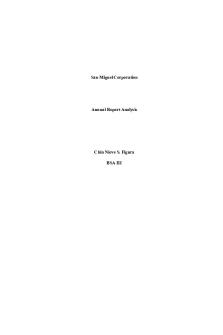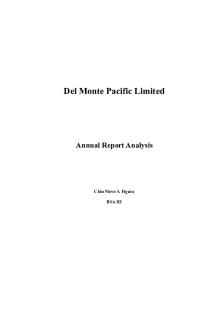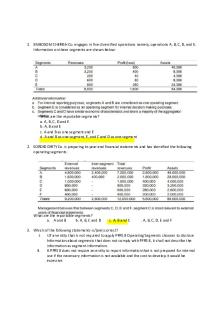Unit 2 Topic 2 IA - dusudid ueifiei ridiiceifi eidi eidiciwi eididiwidiqudyfyvuru rucidicuruuuuudcffu PDF

| Title | Unit 2 Topic 2 IA - dusudid ueifiei ridiiceifi eidi eidiciwi eididiwidiqudyfyvuru rucidicuruuuuudcffu |
|---|---|
| Course | Strategic Cost Management |
| Institution | Batangas State University |
| Pages | 7 |
| File Size | 278.4 KB |
| File Type | |
| Total Downloads | 66 |
| Total Views | 273 |
Summary
EMBOSOM CHERISH Co. engages in five diversified operations namely, operations A, B, C, D, and E. Information on these segments are shown below: What are the reportable segments? a. A, B, C, D and E b. A, B and E c. A and B as one segment and E d. A and B as one segment, E, and C and D as one segment...
Description
1. EMBOSOM CHERISH Co. engages in five diversified operations namely, operations A, B, C, D, and E. Information on these segments are shown below:
What are the reportable segments? a. A, B, C, D and E b. A, B and E c. A and B as one segment and E d. A and B as one segment, E, and C and D as one segment 2. SORDID DIRTY Co. is preparing its year-end financial statements and has identified the following operating segments:
What are the reportable segments? a. A and B b. A, B, C and D
c. A, B and C
. A, B, C, D, E and F
3. Which of the following statements is/(are) correct? I. I.If an entity that is not required to apply PFRS 8 Operating Segments chooses to disclose Information about segments that does not comply with PFRS 8, it shall not describe the information as segment information. II. II.PFRS 8 does not require an entity to report information that is not prepared for internal use if the necessary information is not available and the cost to develop it would be excessive.
III.
III.If a financial report contains both the consolidated financial statements of a parent that is within the scope of PFRS 8 as well as the parent’s separate financial statements, segment information is required only the consolidated financial statements. IV. PFRS 8 requires an entity to report interest revenue separately from interest expense for each reportable segment unless a majority of the segment’s revenues are from interest and the Chief operating decision maker relies primarily on net interest revenue to assess the performance of the segment and to make decisions about resources to be allocated to the segment. PAS 14, the predecessor of PFRS 8, did not require such disclosure. V. V.Generally, an operating segment has a segment manager who is directly accountable to and maintains regular contact with the chief operating decision maker to discuss operating activities, financial results, forecasts, or plans for the segment. VI. VI.The term “segment manager” identifies a function which should be a segment manager with a specific title. a. VI only b. I and c. all except VI d. all of the statements 4. Danggit, a company listed on a recognized stock exchange, reports operating results from its Cebu activities to its chief operating decision maker. The segment information for the year is:
According to PFRS 8 Operating Segments, which piece of information determines for Danggit that the Cebu activities are a reportable segment? a. Revenue b. Profit c. Assets d. Number of employees 5. According to PFRS 8, external revenue reported by reportable operating segments must be at least a. 75% of the total revenue of the entity including both internal and external revenues b. 75% of the total external revenue of the entity c. 10% of the total external revenue of the entity d. a majority of the total revenue of the entity including both internal and external revenues 6. Alexander Company has three business segments with the following information:
What is the minimum amount of revenue that each of those segments must have to be considered reportable? a. P1,950,000 c. P2,250,000
b. P2,100,000
d. P2,370,000
7. In preparing its segment-reporting schedule, the Lorna Corporation has developed the following information for each of its 5 segments: The reportable business segment(s) using the segment result test is (are)
a. b. c. d.
Segment 1, 2, 3, 4 & 5 Segment 1, 2, 3 & 4 Segment 1, 3 & 5 Segment 1, 3, 4 & 5
8. Louie Corporation and its division are engaged solely in manufacturing. The following data pertain to the industries in which operations were conducted for current year:
In its segment information, which is (are) reportable segment/s? a. Segments 1, 2, 3, 4 & 5 b. Segments 1, 2, 3 & 4 c. Segments 1,2 & 4 d. Segments 3 & 5 9. Which of the following statements is incorrect? a. A “management approach” is used in identifying operating segments. b. A reportable operating segment is one which management uses in making decisions about operating matters or results from aggregation of two or more segments and qualify under qany of the quantitative thresholds. c. Even if an operating segment does not qualify in any of the quantitative thresholds, such operating segment may still be reportable if management believes that information about the segment would be useful to users of the financial statements. d. Disclosures for major customer shall be provided if revenues from transactions with a single external customer amount to 75% or more of the entity’s external revenues. 10. Operating segments that may be aggregated are those which exhibit similar economic characteristics and are similar in the following, except a. the nature of the products and services, their production processes, and distribution methods b. the type or class of customer for their products and services c. their financial position, financial performance, and cash flows d. regulatory environment
11. According to PFRS 8, the quantitative thresholds are I. at least 10% of total revenues (external and internal), II. at least 10% of the higher of total profits of segments reporting profits and total losses of segments reporting losses, in absolute amount (i.e., disregarding negative amounts. III. at least 10% of total assets (inclusive of intersegment receivables). a. I only b. II only c. III only d. I, II and III 12. Disclosures for major customer shall be provided if revenues from transactions with a single external customer amount to a. 10% or more of the entity’s external revenues. b. 10% or more of the entity’s external and internal revenues. c. 75% or more of the entity’s external revenues. d. 75% or more of the entity’s external and internal revenues. 13. For segment reporting, interest revenue and interest expense a. are reported separately for each reportable segment b. may be presented at net amount if the chief operating decision maker relies primarily on net c. interest revenue to assess the performance of the segment are not reported d. a or b 14. OBLITERATE TO ERASE Co. included interest expense in its determination of segment profit, which OBLITERATE's chief financial officer considered in determining the segment's operating budget. OBLITERATE is required to report the segment's financial data under PFRS 8. Which of the following items should OBLITERATE disclose in reporting segment data? (Item #1) Interest expense; (Item #2) Segment revenues a. No, No b. No, Yes c. Yes, No d. Yes, Yes 15. Which of the following statements is/(are) correct? I. If an entity that is not required to apply PFRS 8 Operating Segments chooses to disclose information about segments that does not comply with PFRS 8, it shall not describe the information as segment information. II. PFRS 8 does not require an entity to report information that is not prepared for internal use if the necessary information is not available and the cost to develop it would be excessive. III. If a financial report contains both the consolidated financial statements of a parent that is within the scope of PFRS 8 as well as the parent’s separate financial statements, segment information is required only the consolidated financial statements. IV. PFRS 8 requires an entity to report interest revenue separately from interest expense for each reportable segment unless a majority of the segment’s revenues are from interest and the chief operating decision maker relies primarily on net interest revenue to assess the performance of the segment and to make decisions about resources to be allocated to the segment. PAS 14, the predecessor of PFRS 8, did not require such disclosure. V. Generally, an operating segment has a segment manager who is directly accountable to and maintains regular contact with the chief operating decision maker to discuss operating activities, financial results, forecasts, or plans for the segment. VI. The term “segment manager” identifies a function which should be a segment manager with a specific title. a. VI only b. I and II c. all except VI d. all of the statements
16. PFRS 8 aims to help users of financial statements a. Better understand enterprise performance b. Better assess its prospects for future net cash flows c. Make more informed judgments about the entity as a whole d. all of the choices 17. PFRS 8 is required to be applied by a. entities whose equity securities are traded in a public market and those entities who are in the process of filing its financial statements with a securities commission or other regulatory organization for the purpose of issuing any class of instruments in a public market b. entities whose debt and equity securities are traded in a public market. c. entities whose debt and equity securities are traded in a public market and those entities who are in the process of filing its financial statements with a securities commission or other regulatory organization for the purpose of issuing any class of instruments in a public market d. all entities regardless of whether their securities are being traded or not 18. PFRS 8 Operating Segments is applied in I. Separate or individual financial statements II. Consolidated financial statements a. I only b. I and II c. II only d. neither I nor II 19. Which of the following may not be considered as the chief operating decision maker of an entity? a. Chief Executive Officer (CEO) c. Chief Operating Officer (COO) b. Executive Committee d. Shareholders 20. The following are required under PFRS 8 Operating Segments to disclose segment information in its financial statements. I. entities whose equity or debt securities are publicly traded II. entities that are in the process of issuing equity or debt securities in public securities markets III. entities whose securities are not publicly traded or not in the process of issuing securities to the IV. public. a. I and II b. I only c. II only d. None of these 21. A non-publicly listed entity may be required to comply with PFRS 8 Operating Segment if a. the entity is a subsidiary whose parent is a listed entity or in the process of issuing securities to the public even in the entity’s individual (separate) financial statements b. the entity has a foreign operation c. at least majority of its revenues comes from intercompany transactions d. it discloses segment information in its general-purpose financial statements 22. In financial reporting for segments of a business enterprise, which of the following should be taken into account in computing the amount of an industry segment's identifiable assets? (Item #1) Accumulated depreciation; (Item #2) Marketable securities valuation allowance a. No, No b. No, Yes c. Yes, Yes d. Yes, No 23. According to PFRS 8, how do firms identify reportable segments? a. By geographic regions c. By industry classification b. By product lines d. By designations used inside the firm
24. An entity shall report separately information about each operating segment that: I. Management deems relevant to external users II. Meets the quantitative thresholds a. I b. I or II c. II d. neither I nor II 25. Operating segments may be aggregated if a. they have similar economic characteristics b. they have different economic characteristics c. they have the same chief operating decision maker d. the entity has a matrix organization 26. Which of the following tests may be used to determine if an operating segment of an entity is a reportable segment under the provision of PFRS 8 regarding quantitative thresholds? a. Its revenue (both from external customers and internal segments) is equal to or greater than 10 percent of total revenue (external and external). b. The absolute value of its operating profit or loss is equal to or greater than 10 percent of the higher of the total of the operating profit for all segments that reported profits and the total of the losses for all segments that reported losses. c. The segment contains 10 percent or more of the combined assets of all operating segments. d. All of the above. 27. SUBJUGATE CONQUER Corporation sells 5 different types of products. The company is divided for internal reporting purposes into 5 different divisions based on these 5 different product lines. The company should prepare the note disclosure for disaggregated information based upon a. the 5 types of products. b. the 5 different divisions. c. the materialty of each product line based on the revenue or operating profits generated by each product line or the assets utilized by each product line. d. the geographic areas in which the 5 products are sold. 28. Nonreportable segments should a. be aggregated and reported as “all other segments.” b. be aggregated but neither reported nor disclosed c. not reported but may be disclosed if included in the necessary reconciliation of segment assets, liabilities, or profit or loss d. not reported but may be disclosed whether or not included in the necessary reconciliation of segment assets, liabilities, or profit or loss 29. Total external revenue reported by operating segments should a. at least be 75 per cent of the entity’s revenue b. not be more than 75% of the entity’s revenue c. at least be 90% of the entity’s revenue d. no limit set by PFRS 8 30. The term chief operating decision maker a. Refers to a manager with a specific title. b. Must be disclosed by title in the financial reporting for segments.
c. Must be described in the disclosures for the financial reporting for segments. d. Refers to a function of allocating resources to the operating segments and assessing their performance....
Similar Free PDFs

EIDI - EIDI zusammenfassung
- 6 Pages

Financial analysis 2 - IA 2
- 25 Pages

Topic 2 - lecture 2
- 11 Pages

Topic 2
- 1 Pages

Financial analysis 8 - IA 2
- 10 Pages

ia finals 1 and 2
- 19 Pages

Topic 2 Discussion Question 2
- 1 Pages

Topic 2 DQ 1-2
- 1 Pages

Topic 2 - Lecture notes 2
- 22 Pages

Financial analysis 7 - IA 2
- 28 Pages

IA-2 - Lecture notes 1
- 3 Pages

Unit 2
- 10 Pages
Popular Institutions
- Tinajero National High School - Annex
- Politeknik Caltex Riau
- Yokohama City University
- SGT University
- University of Al-Qadisiyah
- Divine Word College of Vigan
- Techniek College Rotterdam
- Universidade de Santiago
- Universiti Teknologi MARA Cawangan Johor Kampus Pasir Gudang
- Poltekkes Kemenkes Yogyakarta
- Baguio City National High School
- Colegio san marcos
- preparatoria uno
- Centro de Bachillerato Tecnológico Industrial y de Servicios No. 107
- Dalian Maritime University
- Quang Trung Secondary School
- Colegio Tecnológico en Informática
- Corporación Regional de Educación Superior
- Grupo CEDVA
- Dar Al Uloom University
- Centro de Estudios Preuniversitarios de la Universidad Nacional de Ingeniería
- 上智大学
- Aakash International School, Nuna Majara
- San Felipe Neri Catholic School
- Kang Chiao International School - New Taipei City
- Misamis Occidental National High School
- Institución Educativa Escuela Normal Juan Ladrilleros
- Kolehiyo ng Pantukan
- Batanes State College
- Instituto Continental
- Sekolah Menengah Kejuruan Kesehatan Kaltara (Tarakan)
- Colegio de La Inmaculada Concepcion - Cebu



